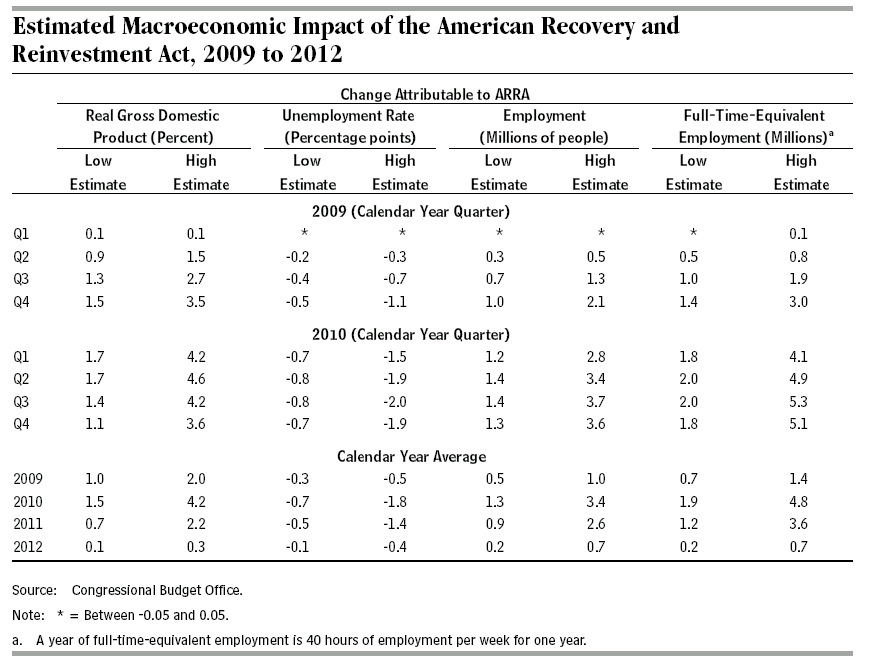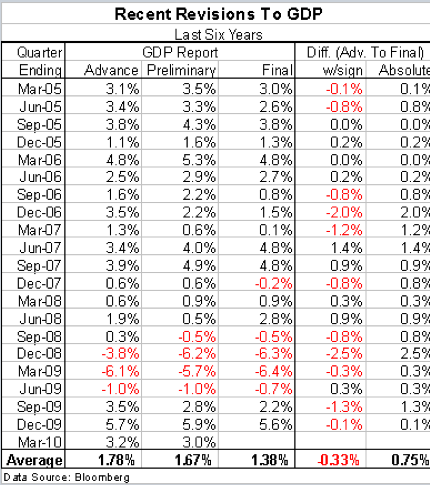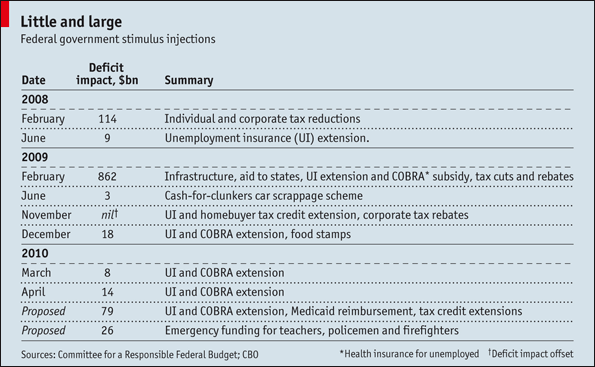<Click on table for larger image>
• Congressional Budget Office (CBO) – Estimated Impact of the American Recovery and Reinvestment Act on Employment and Economic Output from January 2010 Through March 2010
The American Recovery and Reinvestment Act of 2009 (ARRA) contains a variety of provisions intended to boost economic activity and employment in the United States. Section 1512(e) of the law requires the Congressional Budget Office (CBO) to comment on the reports filed by certain recipients of funding under ARRA that detail how many jobs were created or retained through funded activities. This CBO report fulfills that requirement. It also provides CBO’s estimates of ARRA’s overall impact on employment and economic output in the first quarter of calendar year 2010. Those estimates—which CBO considers more comprehensive than the recipients’ reports—are based on evidence from similar policies enacted in the past and on the results of various economic models.
Comment
The table below shows actual GDP statistics over the last six years. Combining it with the table above, some interesting facts are revealed:
• Q3 2009 Final GDP real growth was 2.2%. The CBO estimates that 1.3% to 2.7% was due to government stimulus. So excluding stimulus it is possible Q3 2009 was still negative.
• Q4 2009 Final GDP real growth was 5.6%. The CBO estimates that 1.1% to 3.6% was due to government stimulus. So excluding stimulus it is possible Q4 2009 was as low as 2.0%.
• Q1 2010 Preliminary GDP real growth was 3.0%. The CBO estimates that 1.7% to 4.2% was due to government stimulus. So excluding stimulus it is possible Q1 2010 was still negative.
Add it up and only one quarter of the last seven (Q4 2009) has been able to show real growth in excess of government stimulus.
Let’s be clear … real growth means standards of living are advancing. Real growth means that economies are being more productive and real useful jobs are being created. Government stimulus is an attempt to manipulate growth statistics via inefficient and wasteful government spending. Stimulus does not advance standards of living.
While we agree that the “Great Recession” probably ended in the summer of 2009, the fact that the recovery is so dependent on government stimulus is not an encouraging sign.
~~~
~~~
The Economist – The economy: A sticky gas-pedal
America contemplates yet more fiscal stimulus and leaves the pain for later
Mr Obama’s fiscal policy has been described as “gas now, brake later”: wider deficits in the near term to keep the economy out of depression (which would risk even bigger deficits), followed by a switch to deficit reduction to cap the rise in the national debt. The switch, however, remains a future abstraction. The latest initiatives would bring the total amount of stimulus since Mr Obama took office to well over $1 trillion (see table). Does the economy need all this? Despite turbulent markets, forecasts for American growth this year and next are being revised up, not down. On May 26th, the OECD predicted growth of 3.2% for 2010, up from 2.5% last November. But, it added, “it is unclear if output growth is yet self-sustaining and how the economy will respond as the effect of the stimulus ebbs.”





What's been said:
Discussions found on the web: